
Lot 350
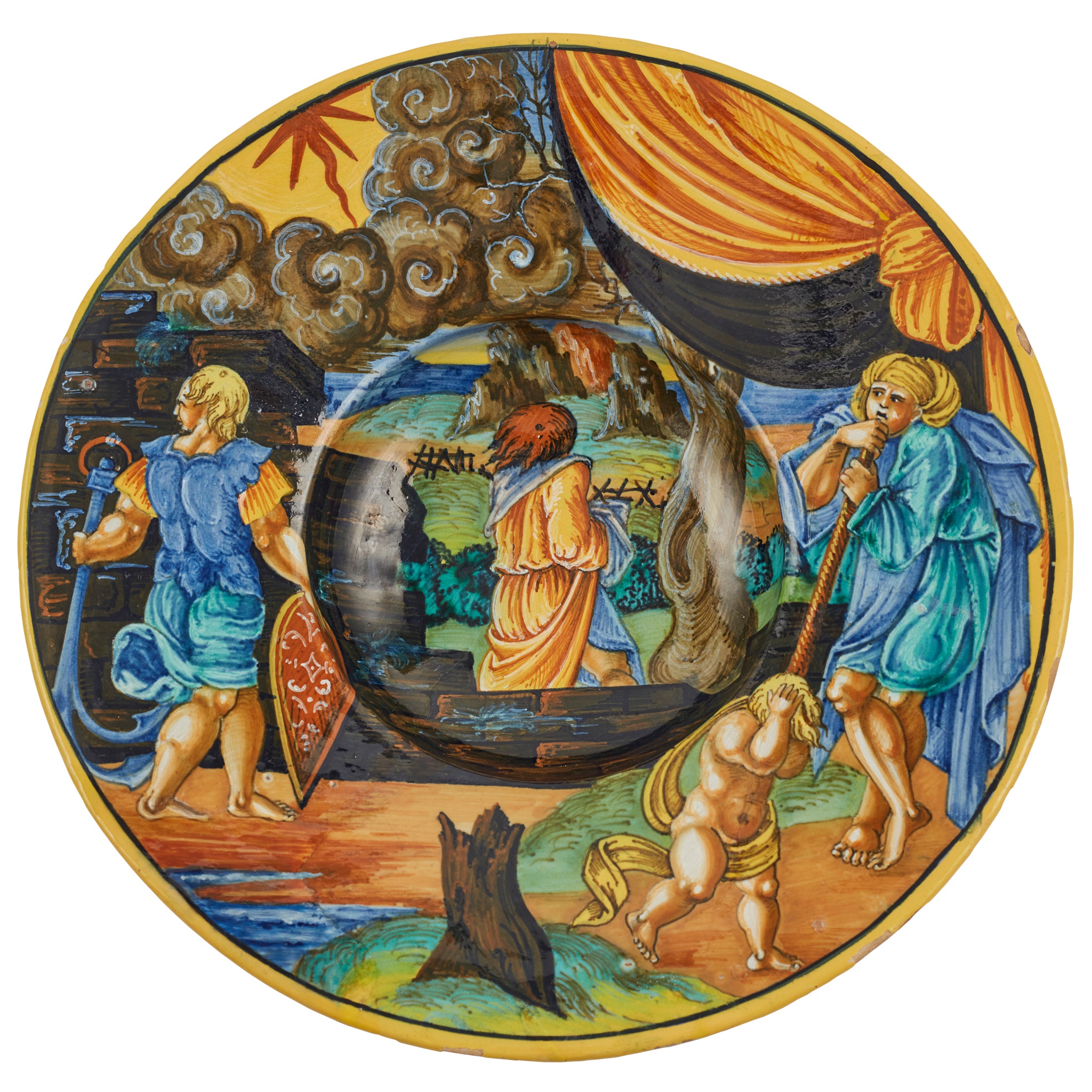
AN UNRECORDED MAIOLICA URBINO DISH WITH BROAD RIM, CIRCLE OF XANTO, PROBABLY BY THE PAINTER 'LU. UR'
DATED 1534
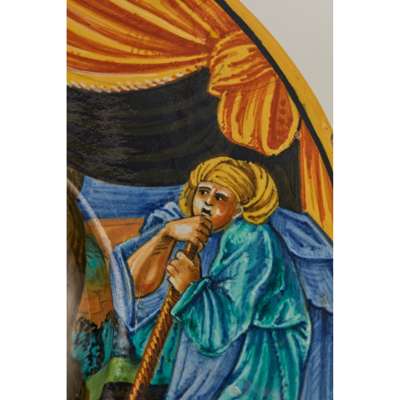
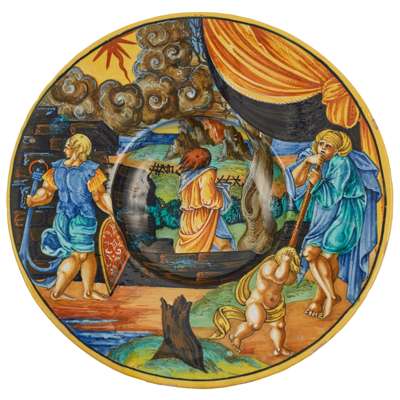
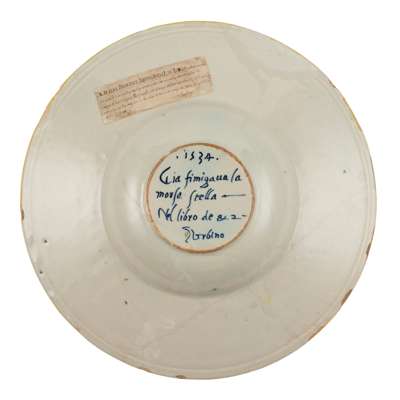
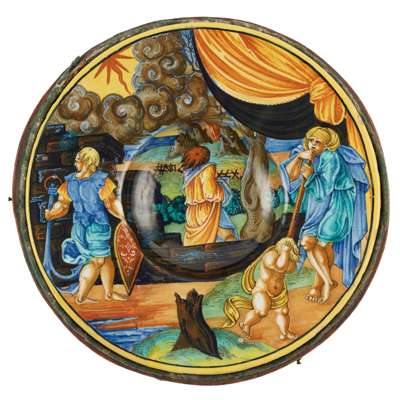
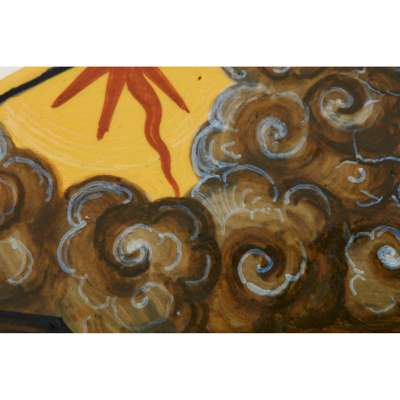







Auction: Day Two | Thurs 13th November 2025 at 10am | Lots 339 to 600
Description
decorated with an allegorical scene, possibly a theme of unrequited love; painted to one side with a figure of a soldier, his left hand holding an anchor, his right a shield, standing with his back to the viewer; the other side painted with a cross legged figure holding a staff, the well of the dish depicting a figure standing on the opposite side of a wall, his back to the viewer and looking onto a landscape of hedges, fences, rocks and hills; the star of Venus shines above, heralding dawn and encircled by clouds; on the lower rim of the dish a draped putto hides his eyes from the light; the reverse is inscribed in underglaze blue: ·1534· / Gia fimigaua la/morso stella - /Nel libro de & Z- /I[n] Urbino’ (Already the loving star was flaring - / In the book of & Z -/ In Urbino); there is also a paper label on reverse with a written inscription [1]
Dimensions
26.2cm diameter
Provenance
Private collection
Footnote
This dish is a period version or copy of a plate painted with the same subject and date, signed by one of the masters of ‘istoriato’ painting Francesco Xanto Avelli, which is in the Fitzwilliam, Cambridge[2]. Here the title on the reverse of the plate is also copied from the first line of Petrarch’s Rime 33 and the subject inscription, shortened and misspelt, reads as ‘.1534· /Gia fiameggiaua l’/amorosa stella’ (Already the loving star was flaring).[3]
A second version of this subject after Petrarch with a similar (but not identical) inscription on the back, also dated 1534 but unsigned, was formerly in the Damiron[4] and then the Sackler[5] collections and is also attributed to the painter known as ‘Lu.Ur.’ an associate of Xanto. As with the Xanto Fitzwilliam and the ‘Lu.Ur.’ Damiron dishes the figure on the left on our bowl is a version of the engraved figure of Sol by the monogramist I.B. (George Pencz), an image often used by Xanto[6]. The figure of the Putto on all these three plates is a version of Cupid from Agostino Veneziano’s print of the Death of Cleopatra after Raphael,[7] and the central figure on all three versions is taken from Marcantonio Raimondi’s Martyrdom of Saint Lawrence after Baccio Bandinelli [8]. The only significant difference between our dish, the Xanto Fitzwilliam and the ’Lu.Ur.’ Damiron dishes is the figure on the right. However, it too is simply a different figure copied from the same Raimondi engraving[9] and was used by Xanto at this date in possible collaboration with ‘Lu.Ur.’[10] on at least one other occasion.
The dish being offered by Lyon and Turnbull also relates to a series of plates (dated 1533/4) some of which have on the reverse the additional inscribed spurious reference ‘Nel libro de ‘ (in the book of..) plus the same distinctive capital ‘I’ as in ‘I[n] Urbino’. One of these inscribed dishes has been attributed to Giulio da Urbino[11], the other to the painter known as ‘Lu.Ur.’[12], both regarded as assistants or collaborators of Xanto and provides further evidence of the close links between these three maiolica masters at this date.
[1] This reads “A.D.1535. FRANCESCO, XANTO, AVELLÈ, DA. ROVIGO; whose works are so well known & so highly appreciated; he usually painted after the designs of drawings of Raphael, not always adhering strictly to the same graphics of the origins, he also borrowed subjects from Virgil, Ovid, Ariosto et cet”. “Chaffers” . This note seems to have been copied verbatim from ‘ Marks and Monograms on Europe and Oriental Pottery and Porcelain ’ by William Chaffers, edited by Frederick Litchfield, and is only found in the 9th edition published in 1900
[2] Poole, J., Italian Maiolica and incised slipware in the Fitzwilliam Museum Cambridge, Cambridge 1995, cat395, p346-8
[3] This couplet with the date 1534 is also found with a different image on the front on another plate signed by Xanto in Brunswick. See Ballardini, G., Corpus della maiolica italiana, 11, Le maioliche datate dal 1531 al 1535, Rome 1938, cat140 (fig134) and Lessmann J., Italienische Majolika, Katalog der Sammlung, Herzog Anton Ulrich Museum, Braunschweig, p564, plV!
[4] Damiron Sale 1938, Sotheby’s, London, 16th June 1938, lot 39
[5] Sackler Sale 1993-4, Christie’s, New York, pt2, 1st June 1994, lot 23
[6]The illustrated Bartsch 16, 1980, formerly volume 8 (part3). Early German Masters, Jacob Bink, Georg Pencz, Heinrich Aldgraver, ed Robert A. Kock, New York, p70, n14
[7] The illustrated Bartsch 26, 1978 volume 26 formerly volume 14 (part1). The works of Marcantonio Raimondi and of his school, ed. Konrad Oberhuber, New York, p194, no198
[8] Ibid.,p136,n104-11
[9] Ibid.
[10] See Mallet, J.V.G., with contributions by Hendel, G., Higgott, S.,and Sani, E.P., Xanto, Pottery-Painter, Poet, Man of the Italian Renaissance, Ex Cat Wallace Collection, London 2007, Cat46, p140, for a plate, The Battle of Pavia signed by Xanto but decorated with possible assistance from ‘Lu.Ur.’ with this figure.
[11] Wilson, Timothy, The Golden Age of Italian Maiolica Painting, Catalogue of a Private Collection, Turin 2018, cat114, p262-5
[12] Sackler Sale 1993-4, Christies, New York, pt2, 1st June 1994, lot 22
With special thanks to Celia Curnow for researching and cataloguing this lot.











